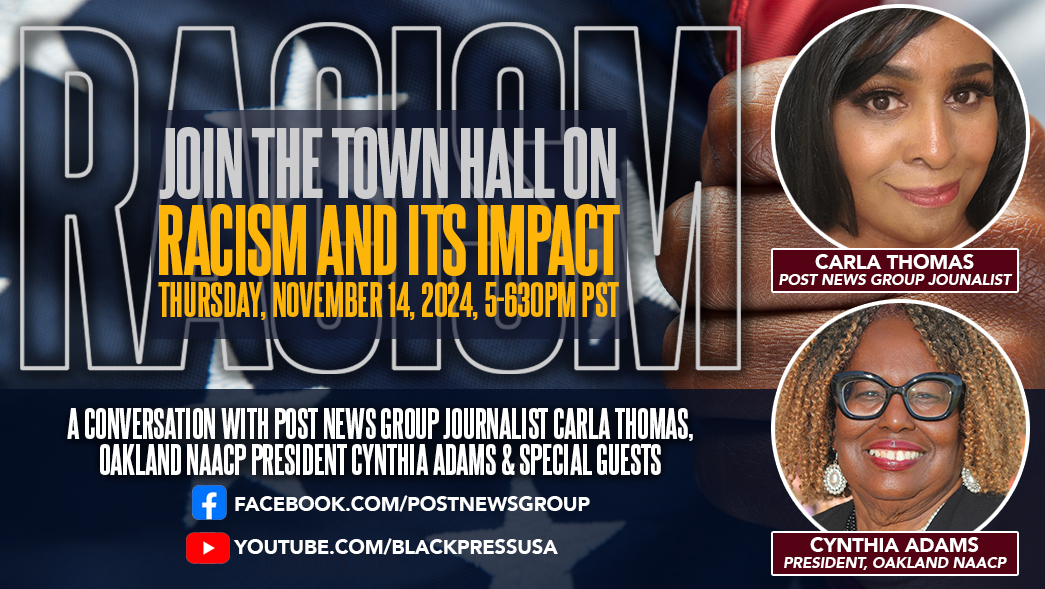Education
Students and Board Members Weigh-in on School Changes
Student and teacher speakers at Wednesday night’s board meeting raised their concerns about the school redesign process that the district administration has initiated at five Oakland schools.
In interviews with the Oakland Post, school board members also discussed the process that is now getting under way.
Speaking at the meeting Edgar, a Fremont High senior, said, “Fremont is a great school and has a lot of diversity. We are not failing. We are constantly improving.”
He continued: “You need to involve yourself in our community. How can you help us if you don’t involve yourselves in our struggles? We need more books, better facilities and more resources.”
Another Fremont student said, “You guys aren’t scientists, so don’t try to experiment on us. This is not a business – this an education. It’s a necessity.”
So far, this process “was sneaky and not transparent,” said a Fremont instructor. “Our parents and students know what they need. How about giving us more counselors – we only have one.”
“We need (more) quality teachers. We need restorative justice,” the instructor said. We know what we need. Why don’t you put some money behind it?”
Fremont senior Rosa Contreras said, “I do not believe Fremont should be labeled a failing school. You don’t even know us. I want to see the money (promised two years ago) start going to our school now – not later – now.
A student from Castlemont said. “We have not had a steady principal for three years. We don’t know what to trust anymore.”
Another speaker was Mike Hutchinson, who said the district could regain public confidence if the board simply deletes charter school from the redesign process. “The board could remove any language about giving the schools to charters from the policy.”

District 5 Boardmember Roseann Torres said that she was deeply impressed with the leadership exhibited by the students at Fremont High at the community meeting she attended last week and urged the district support the students.
She said that the unity between Latino and African Americans students was wonderful to see, that the racial divisions exist in Oakland are more about the attitudes of adults and based on the past.
In addition, Torres said she does not want to hear any more reports of administrators taking students outside and trying to intimidate them into not speaking their minds at these community meetings.
“I think this (process) is a bit rushed, and it’s a big shock” coming so soon after the school bond Measure N passed in November, she said in an interview with the Post.
“It is somewhat disrespectful (to tell students) you don’t know what’s good for you,” she said. “These kids (at Fremont) know that Oakland Technical High has a lot more money” – for resources such as sports uniforms and after school activities, “But they have nothing, and these are both public schools.”
Board President James Harris, who represents District 7, said the community needs to give the redesign process time to mature, and “You will see what will emerge.”
“This is based on the community. This is not about a top-down decision telling the community what’s best for them,” Harris said.
The district administration is “acknowledging the needs of each school site,” he said. “What’s good for one site” is not necessarily good for another one.
“I’m not going to vote for what the community doesn’t want,” Harris said, pointing that some charters work because they have grassroots buy-in. “There are charters that work and charters that don’t,” he said.
Shanthi Gonzales, who represents District 6, said she is looking forward to the seeing administrative regulations that will govern this process.
“Those are the details about how this process will be carried out, and what I’m especially interested in is transparency. I feel strongly that there should be community representation on the Academic Review Panel that recommends proposals to the board, so that the public is part of the deliberation and sees how these decisions will be made,” she said.
“These schools belong to all of us, and we need to assert our rights to participate in the decisions that are being made about them. That is why I will be looking hard at how we are including the public in every aspect of the process. Not just, can they participate at their schools – which they should – but also in reviewing the proposals and making recommendations to the board.”
Activism
LIVE! — TOWN HALL ON RACISM AND ITS IMPACT — THURS. 11.14.24 5PM PST
Join us for a LIVE Virtual Town Hall on the Impact of Racism hosted by Post News Group Journalist Carla Thomas and featuring Oakland, CA NAACP President Cynthia Adams & other Special Guests.
Thursday, November 14, 2024, 5 p.m. – 6:30 p.m. PST

Join us for a LIVE Virtual Town Hall on the Impact of Racism hosted by Post News Group Journalist Carla Thomas and featuring Oakland, CA NAACP President Cynthia Adams & other Special Guests.
Thursday, November 14, 2024
5 p.m. – 6:30 p.m. PST
Discussion Topics:
• Since the pandemic, what battles have the NAACP fought nationally, and how have they impacted us locally?
• What trends are you seeing concerning Racism? Is it more covert or overt?
• What are the top 5 issues resulting from racism in our communities?
• How do racial and other types of discrimination impact local communities?
• What are the most effective ways our community can combat racism and hate?
Your questions and comments will be shared LIVE with the moderators and viewers during the broadcast.
STREAMED LIVE!
FACEBOOK: facebook.com/PostNewsGroup
YOUTUBE: youtube.com/blackpressusatv
X: twitter.com/blackpressusa
Art
Brown University Professor and Media Artist Tony Cokes Among MacArthur Awardees
When grants were announced earlier this month, it was noted that seven of the 22 fellows were African American. Among them are scholars, visual and media artists a poet/writer, historian, and dancer/choreographer who each receive $800,000 over a five-year period to spend as they see fit. Their names are Ruha Benjamin, Jericho Brown, Tony Cokes, Jennifer L. Morgan, Ebony G. Patterson, Shamel Pitts, Jason Reynolds, and Dorothy Roberts. This is the third in the series highlighting the Black awardees.

Special to The Post
When grants were announced earlier this month, it was noted that seven of the 22 fellows were African American. Among them are scholars, visual and media artists a poet/writer, historian, and dancer/choreographer who each receive $800,000 over a five-year period to spend as they see fit. Their names are Ruha Benjamin, Jericho Brown, Tony Cokes, Jennifer L. Morgan, Ebony G. Patterson, Shamel Pitts, Jason Reynolds, and Dorothy Roberts. This is the third in the series highlighting the Black awardees. The report below is excerpted from the MacArthur Fellows web site.
Tony Cokes
Tony Cokes, 68, is a media artist creating video works that recontextualize historical and cultural moments. Cokes’s signature style is deceptively simple: changing frames of text against backgrounds of solid bright colors or images, accompanied by musical soundtracks.
Cokes was born in Richmond, Va., and received a BA in creative writing and photography from Goddard College in 1979 and an MFA from Virginia Commonwealth University in 1985. He joined the faculty of Brown University in 1993 and is currently a professor in the Department of Modern Culture and Media.
According to Wikipedia, Cokes and Renee Cox, and Fo Wilson, created the Negro Art Collective (NAC) in 1995 to fight cultural misrepresentations about Black Americans.[5]
His work has been exhibited at national and international venues, including Haus Der Kunst and Kunstverein (Munich); Dia Bridgehampton (New York); Memorial Art Gallery University of Rochester; MACRO Contemporary Art Museum (Rome); and the Carpenter Center for the Visual Arts (Harvard University), among others.
Like a DJ, he samples and recombines textual, musical, and visual fragments. His source materials include found film footage, pop music, journalism, philosophy texts, and social media. The unexpected juxtapositions in his works highlight the ways in which dominant narratives emerging from our oversaturated media environments reinforce existing power structures.
In his early video piece Black Celebration (A Rebellion Against the Commodity) (1988), Cokes reconsiders the uprisings that took place in Black neighborhoods in Los Angeles, Detroit, Newark, and Boston in the 1960s.
He combines documentary footage of the upheavals with samples of texts by the cultural theorist Guy Debord, the artist Barbara Kruger, and the musicians Morrisey and Martin Gore (of Depeche Mode).
Music from industrial rock band Skinny Puppy accompanies the imagery. In this new context, the scenes of unrest take on new possibilities of meaning: the so-called race riots are recast as the frustrated responses of communities that endure poverty perpetuated by structural racism. In his later and ongoing “Evil” series, Cokes responds to the rhetoric of the Bush administration’s “War on Terror.”
Evil.16 (Torture.Musik) (2009–11) features snippets of text from a 2005 article on advanced torture techniques. The text flashes on screens to the rhythm of songs that were used by U.S. troops as a form of torture.
The soundtrack includes Metallica’s “Enter Sandman” and Britney Spears’s “… Baby One More Time,” songs known to have been played to detainees at deafening decibel levels and on repeated loops. The dissonance between the instantly recognizable, frivolous music and horrifying accounts of torture underscores the ideological tensions within contemporary pop culture.
More recently, in a 2020 work entitled HS LST WRDS, Cokes uses his pared-down aesthetic to examine the current discourse on police violence against Black and Brown individuals. The piece is constructed around the final words of Elijah McClain, who was killed in the custody of Colorado police. Cokes transcribes McClain’s last utterances without vowels and sets them against a monochromatic ground. As in many of Cokes’s works, the text is more than language conveying information and becomes a visualization of terrifying breathlessness. Through his unique melding of artistic practice and media analysis, Cokes shows the discordant ways media color our understanding and demonstrates the artist’s power to bring clarity and nuance to how we see events, people, and histories.
California Black Media
On Your November Ballot: Prop 2 Seeks to Modernize Public Education Facilities
Proposition 2 would authorize the state to issue $10 billion in bonds with $8.5 billion dedicated to elementary and secondary educational facilities and $1.5 billion for community college facilities. If approved, the proposition will make changes to the formula used to determine the amount each district is required to contribute to be eligible to receive state funding from the bond revenue. It would also require the state government to cover between 50 and 55% of construction project costs and 60 and 65% of modernization project costs.

By Edward Henderson, California Black Media
Proposition 2 would authorize the state to issue $10 billion in bonds with $8.5 billion dedicated to elementary and secondary educational facilities and $1.5 billion for community college facilities.
If approved, the proposition will make changes to the formula used to determine the amount each district is required to contribute to be eligible to receive state funding from the bond revenue. It would also require the state government to cover between 50 and 55% of construction project costs and 60 and 65% of modernization project costs.
Supporters argue that the money is critical for making safety improvements in schools, as well as modernizing science labs, performing arts spaces and kindergarten classrooms. School districts in lower-income areas have no other way to pay for these improvements.
According to the Public Policy Institute of California, 38% of students attend schools that don’t meet the state’s minimum safety standards. The research shows that schools with sub-standard facilities tend to have students with lower attendance rates, lower morale and lower overall academic performance.
California Black Media spoke with a Los Angeles Unified School District (LAUSD) spokesperson on why she believes it should be a YES vote on Prop 2.
“Measure US, Los Angeles Unified’s Local Public Schools Safety and Upgrades Measure on the November ballot would provide $9 billion to upgrade Los Angeles public schools for safety and 21st century student learning and college and career preparedness. The average annual cost to property owners is estimated at 2.5 cents per $100 of assessed (not market) property value. The Los Angeles Unified Board of Education adopted a Resolution on October 22 to support Los Angeles Unified’s Measure US, and State Propositions 2 and 4,” the spokesperson said.
Opponents argue that the state should include school repairs in its regular budget instead of putting the burden on taxpayers. Opponents also argue that the proposition would not directly impact students. The Howard Jarvis Taxpayers Association is on record as one of the organizations opposing the proposition.
“Proposition 2 is $10 billion of bonds, new state debt, to pay for school facilities. It is almost certain to result in higher property tax bills, because school districts must provide a ‘local match’ of funds in order to receive money from the Prop. 2 state bonds. That will lead to districts issuing new local school bonds, which are paid for by adding new charges to property tax bills,” said Jarvis.
Opponents also have voiced concerns about what they view as an inequitable distribution of funds. They believe that lower-income school districts should receive a greater share of the state’s sliding scale for matching funds.
“Enrollment is declining in both K-12 district schools and community colleges and the declines are projected to continue. But Proposition 2 commits California to pay an estimated $18 billion, including interest, for school buildings that may not even be necessary. Vote no on proposition 2.”
A “yes” vote gives approval to the state to issue $10 billion in bonds to fund construction and modernization of public education facilities.
A “no” vote will prohibit the state from issuing $10 billion in bonds to fund construction and modernization of public education facilities.
-

 Alameda County3 weeks ago
Alameda County3 weeks agoAlameda County District Attorney Pamela Price Announces $7.5 Million Settlement Agreement with Walmart
-

 Activism3 weeks ago
Activism3 weeks ago‘Jim Crow Was and Remains Real in Alameda County (and) It Is What We Are Challenging and Trying to Fix Every Day,’ Says D.A. Pamela Price
-

 Bay Area3 weeks ago
Bay Area3 weeks agoIn the City Attorney Race, Ryan Richardson Is Better for Oakland
-

 Activism3 weeks ago
Activism3 weeks agoOakland Post: Week of October 30 – November 5, 2024
-

 Alameda County2 weeks ago
Alameda County2 weeks agoD.A. Price Charges Coliseum Flea Market Vendors in Organized Retail Theft Case
-

 Activism3 weeks ago
Activism3 weeks ago‘Criminal Justice Reform Is the Signature Civil Rights Issue of Our Time,’ says D.A. Pamela Price
-

 Activism3 weeks ago
Activism3 weeks ago“Two things can be true at once.” An Afro-Latina Voter Weighs in on Identity and Politics
-

 Arts and Culture3 weeks ago
Arts and Culture3 weeks agoMacArthur Fellow Jericho Brown’s Poetry Reflects Contemporary Culture and Identity





















































